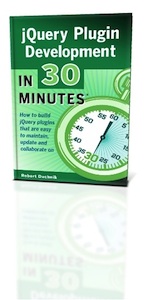When people ask me about sales of In 30 Minutes guides, I tell them that the paperback editions generally sell the most copies. However, I’ve learned to expect a different sales pattern for the recently-released jQuery Plugin Development In 30 Minutes. Because this guide targets a different, niche audience (Web developers), the jQuery Plugin PDF version may end up being the best seller over time.
At first glance, PDFs may not seem like a strong candidate for breakout sales. PDFs are an older digital technology, which has its roots in print publishing. Created by Adobe Systems in the early 1990s, a PDF page is designed to appear on a computer screen exactly as it would were it printed out on paper. It has some additional properties, including the ability to add links and a table of contents. In addition, the text within most PDFs is searchable. However, unlike more modern ebook formats such as ePub and .mobi, PDF text can’t be scaled to a larger or smaller font on a computer screen or ereader such as the Kindle. And, not all PDF reader applications allow highlighting, annotations, or “bookmarks” that let readers quickly return to a favorite passage.
But PDFs do have advantages over ePub and .mobi files. The first is flexibility: A PDF can be read on practically any screen or printed out. This means you can switch between a PC, Kindle, and iPad, and print out all or part of the PDF document. In addition, the text in a PDF can be copied and pasted (with some limitations; text is sometimes out of order when it’s pasted into a text file or Word document, and the formatting is usually broken).
Finally, PDFs are a stable format. A PDF from 20 years ago still looks the same, whether it’s on the screen or printed out. It is not certain whether ePub or .mobi files will have the same consistency. Indeed, different ereaders and ebook software don’t treat ePub files in the same way — Robert Duchnik, the author of jQuery Plugin Development In 30 Minutes, told me that when he attempted to read the ePub version of the guide on an ereader application for his Windows PC, the formatting was broken, even though it looked fine when I tested it on other devices.
For Web developers studying jQuery Plugin development, the PDF version of jQuery Plugin Development In 30 Minutes is an attractive option compared to the ebook or paperback editions. The ability to easily copy and paste with a mouse on a computer screen means that the code samples in the PDF version of jQuery Plugin Development In 30 Minutes can be quickly brought into eMacs, Notepad ++, Komodo Edit or some other code or text editor. Links are also easy to access and bookmark when the PDF is read on a computer screen.
Finally, many programmers are used to buying PDF books. When people on Hacker News discuss programming books, PDFs seem to be the preferred format. When it’s not available, people will ask for it.
The jQuery Plugin Development In 30 Minutes PDF is available on the official companion site for the guide.
You may also enjoy reading the following blog posts:

